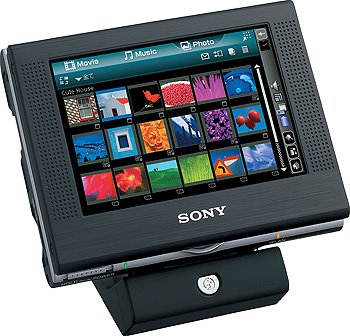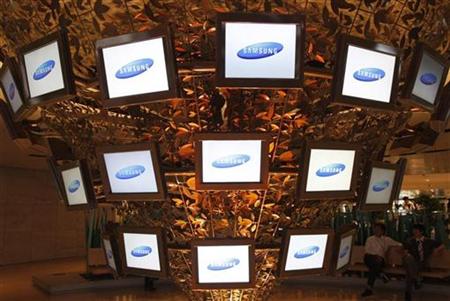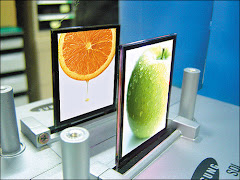THANKS FOR VISITING OUR BLOG! PLEASE CLICK HERE TO SEE OUR QUICKER LOADING BLOG THAT'S IN BETA STAGE!
ALSO WATCH FOR OUR CONTESTS FOR GREAT PRIZES COMING IN 2009!
With the recent increase in LCD sales driven in most part by the upcoming digital tv conversion within the USA, prices are finally at a point where just about any household will own an LCD type of flat panel display (FPD). So with this huge increase in LCD sales plus the lower cost to manufacture LCD displays, there is a void now created within the electronic world that must be filled.
In 2008 this void looks like its being filled by the latest in the OLED (Organic Light-Emitting Diode) or PH-OLED (Phosphorescent-Organic Light-Emitting Diode) technology, the high end, all singing, all dancing, fully optioned, mother of all displays available to man today. A tv made from phosphorescent organic materials, as razorthin as a slice of your favourite deli meat and a screen image as memorable as the first time I laid eyes on a spanking new Sony Trinitron back in the day.
Organic television has arrived! The very pinnacle of FPD technology that is bio friendly, safe, more energy efficient, cost effective, with applications within an ever growing number of useful electronic and related products to help and enhance our daily lives.
Japanese electronics giant Sony released details today on their plans to ramp up their technology to develop medium to large screen OLED TV's. Starting in mid 2008 this injection of capital will help to expand on further development at Sonys Mobile Display Corporation Plant (SMD), technology relating to the deposition of light-emitting layer sub-strates as well as the manufacturing of low temperature polysilicon transistors (LPTS). With this influx of funds to expand on the facility the end goal being the ability to manufacture larger OLED display panels for use within various commercial and retail sectors.
The major issues with OLED is the limited size of the organic displays along with the present high costs to manufacture them. As a comparison, glass substrates from which organic panels are cut are 600mm x 720mm & 550mm x 650mm. Seventh and eight generation LCD plants use sub-strates up to a whopping 2200mm x 2500mm. So in comparison with Sony's OLED technology today, OLED development is equivalent to approximately a third generation or possibly a 3.5 generation LCD plant. The projected production date for large screen OLED display at the SMD plant is by early 2010.
One other advantage of OLED panels (other than the many obvious ones) is the lower manufacturing process costs of OLED compared to LCD. Since OLED tech is emissive, meaning when the organic molecules phosphorize to emit photons equaling light the electroluminescense is relying on the organic molecules to generate white light called WOLED. By tailoring the compositions of the organic materials it is also possible to create devices that emit coloured light as well.
Japanese electronics giant Sony released details today on their plans to ramp up their technology to develop medium to large screen OLED TV's. Starting in mid 2008 this injection of capital will help to expand on further development at Sonys Mobile Display Corporation Plant (SMD), technology relating to the deposition of light-emitting layer sub-strates as well as the manufacturing of low temperature polysilicon transistors (LPTS). With this influx of funds to expand on the facility the end goal being the ability to manufacture larger OLED display panels for use within various commercial and retail sectors.
The major issues with OLED is the limited size of the organic displays along with the present high costs to manufacture them. As a comparison, glass substrates from which organic panels are cut are 600mm x 720mm & 550mm x 650mm. Seventh and eight generation LCD plants use sub-strates up to a whopping 2200mm x 2500mm. So in comparison with Sony's OLED technology today, OLED development is equivalent to approximately a third generation or possibly a 3.5 generation LCD plant. The projected production date for large screen OLED display at the SMD plant is by early 2010.
One other advantage of OLED panels (other than the many obvious ones) is the lower manufacturing process costs of OLED compared to LCD. Since OLED tech is emissive, meaning when the organic molecules phosphorize to emit photons equaling light the electroluminescense is relying on the organic molecules to generate white light called WOLED. By tailoring the compositions of the organic materials it is also possible to create devices that emit coloured light as well.
White OLED is now taking a big leap in the advancement of the next generation of commercial and household lighting. It looks like SSL (Solid-State Light) WOLED is the new frontier in how we will be lighting our way in the years to come. With involvement of the big corporations today and in time to come, OLED is such a versatile technology with applications within many products.
OLED is created by applying the phosphorescent materials onto glass or plastic / polymer sub-strates which allow for their unbelievable ultra-thin displays. There are many ways PHOLED can be manufactured: organic vapour phase deposition, ink-jet printing, laser-induced thermal imaging, spin coating, and organic vapour jet printing. For low-cost manufacturing of high-efficancy PHOLED's the choice of fabrication method depends on operational costs, length of processing time, reproductability of device performance, and the organic material's compatibility with the particular process. PHOLEDs may one day be manufactured using roll-to-roll processes similar to those used to create magazines and books.
In comparison with the back-lit technolgy utlized within LCD, the manufacturing costs of OLED will be much less per unit, making OLED a much better FPD (Flat Panel Display) choice in the long run. As with any new technology with such major backers which is so cutting edge, to successfully become integrated into society en masse as LCD and plasma has for a number of years, is a long term committment by these corporations. The recent drop in LCD TV and LCD monitors has given the electronics industry another major boost. Plus with the upcoming USA 2009 conversion to all digital TV signal means more FPD's will be sold within the USA, so it opens the door for OLED TV and all the other OLED related product's to take center stage in the ever expanding, hugely exciting organic electronics industry today.
Due to the past difficulties in the blue spectrum and the problems associated with larger organic display's, once issues such as these are properly addressed and dealt with in research, like these types of corporations can do, then OLED should reach 40" by mid 2009 - 2010 quite easily with the advancements of continuous research. It seems each day a new OLED related news release is made on any web news feed, so this is certainly a good indicator of the continued growth of the market. For the record 2007 - early 2008 has shown to be a time when a large number of the technical barriers within some of these concerns have been rectified or at least dramatically improved upon from say 1 year ago even.
There is a huge array of major corporations such as Samsung SDI, Toshiba, Sony, Hitachi, Canon, Toyota Ind., Matsushita / Panasonic, Universal, Display, the list goes on, on and who are involved in niches of OLED such as; FOLED - Flexible OLED, AMOLED - Active Matrix OLED, Passive Matrix OLED, WOLED - White OLED, PHOLED - Phosphourescent OLED. As far as the concerns over the high retail price of OLED in the stores when the numbers are calculated they show that the tooling costs for the OLED plants to gear up to manufacture OLED displays will be gained back much quicker in comparison to LCD due to the very nature of how organics are be created. Much less equipment, parts, labour, lower all around processing costs when compared to LCD means that even though OLED is much better technology, it doesn't mean that it has to cost more to be superior.
One other cost savings aspect is that if you go as far into the FPD industry to the level of transportation costs. This one fact alone will eventually help in reducing the processing costs for the plants in a much quicker time-frame than LCD, hence the costs savings of the OLED display's will be passed on to consumers much quicker then LCD had.
Samsung SDI has also announced it is engaging in expansion plans for the ramping up of their second phase in AM-OLED (active matrix OLED) production, many are referring to as " dream displays" within the industry. This move is intended to double production from the current 1.5 million to 3 million by cutting costs, wherever that may be is unsure at the moment however. SDI has invested 480 billion Won in its Cheonan, South Chungcheong Province plant saying production would double monthly output last October.
With Sony, Samsung SDI, Toshiba, Matsushita, Toyota Industries, Universal Display, Foled, Canon, and many more major players that have shaped the world of electronics now involved in the mass production of OLED display technology, the future looks razorthin, super sharp and bio friendly folks!
Samsung SDI has also announced it is engaging in expansion plans for the ramping up of their second phase in AM-OLED (active matrix OLED) production, many are referring to as " dream displays" within the industry. This move is intended to double production from the current 1.5 million to 3 million by cutting costs, wherever that may be is unsure at the moment however. SDI has invested 480 billion Won in its Cheonan, South Chungcheong Province plant saying production would double monthly output last October.
With Sony, Samsung SDI, Toshiba, Matsushita, Toyota Industries, Universal Display, Foled, Canon, and many more major players that have shaped the world of electronics now involved in the mass production of OLED display technology, the future looks razorthin, super sharp and bio friendly folks!
Oledevices.com - copyright 2008 - all rights reserved


































































































1 comment:
very interesting post
Post a Comment